

4. Модели, системы и стандарты системы дистанционного обучения. El-a-z-28-12-11-stand Online Class by Vladimir Kukharenko. Вебинары 4 неделя. Аналитика Неделя № 4. Поздравляем всех с новым годом и даем аналитику недели № 4 Вот ссылка на архив твиттера.
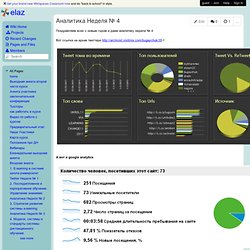
Learning Networks: e-Learning 3.0. 8 Reasons to Focus on Informal & Social Learning. UNESCO ICT Competency Framework for Teachers – Version 2.0. An updated publication designed to help training teachers on ways to optimize the use of information and communication technologies in the classroom has been launched early November 2011 by UNESCO in cooperation with the Commonwealth of Learning, Intel and Microsoft.
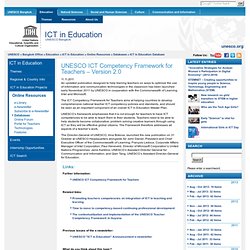
The ICT Competency Framework for Teachers aims at helping countries to develop comprehensive national teacher ICT competency policies and standards, and should be seen as an important component of an overall ICT in Education Master Plan. UNESCO’s framework emphasizes that it is not enough for teachers to have ICT competencies to be able to teach them to their students. Teachers need to be able to help students become collaborative, problem solving creative learners through using ICT so they will be effective global citizens.
The Framework therefore addresses all aspects of a teacher’s work. Kevin Stranack » Major Project: Designing Instructional Plans. Caffarella describes the process of developing instructional programs as “designing the interaction between learners and instructors and/or learners and resource materials for each education and training activity”.
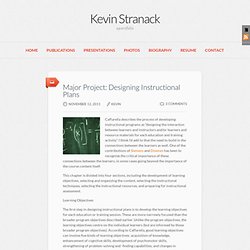
I think I’d add to that the need to build in the connections between the learners as well. One of the contributions of Siemens and Downes has been to recognize the critical importance of these connections between the learners, in some cases going beyond the importance of the course content itself. This chapter is divided into four sections, including the development of learning objectives, selecting and organizing the content, selecting the instructional techniques, selecting the instructional resources, and preparing for instructional assessment. From Dinosaurs to Dolphins: Technological Evolution in Education « Mutterings and Musings of a Mere Mortal Muggle.
21st Principal’s Big List of Must-Have Administrator Tech Knowledge. Eric Sheninger: Overcoming Obstacles to Change. It seems that no matter where you go or what you read these days someone is talking about the need for change in education.
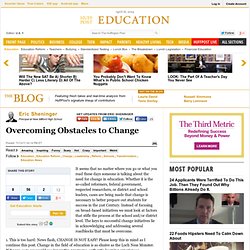
Whether it is the so-called reformers, federal government, respected researchers, or district and school leaders, cases are being made that change is necessary to better prepare out students for success in the 21st Century. Instead of focusing on broad-based initiatives we must look at factors that stifle the process at the school and/or district level. The keys to successful change initiatives lie in acknowledging and addressing several roadblocks that must be overcome. 1.
This is too hard: News flash, CHANGE IS NOT EASY! 2. 3. 4. 5. 6. 7. 8. 9. 10. On the Nature of Change in Higher Ed (Part II): Education and the New Economy - Tenured Radical. We return to guest blogger, historian and former Zenith provost Judith C. Brown. Her full biography and Part I of this series can be viewed here. Brown ended the first section of her essay by reflecting: “in the early 19th century, it was in the relative ‘backwater’ of the German universities as well as in the newer universities of Europe, where imagination and flexibility with regard to change were able to flourish, that we see the beginnings of the modern research university.”
She then asked: “Are we in that kind of turning point in American higher education?” The answer is yes. American higher education is at a major turning point. The Future of E-Learning is Crowdsourcing. Call me a skeptic, but the idea of having random people from around the Web collaborating in the creation of e-learning content for accredited online degree programs seems absurd.

I went to graduate school for years, read hundreds of books and thousands of articles, sat through countless hours in the classroom, participated in dozens of instructional design projects, created and taught several classes under the supervision of experienced professors, and worked with my classmates and people with real world experience solving actual problems in order to earn my Ph.D. and the right to be both a content area expert and an instructional design professional. And along the way, I learned one lesson which surpasses all the others: good instructional design requires a collaborative effort. What is Crowdsourcing? Even ten years ago, the concept of crowdsourcing was completely alien to the average person. Image: fotographic1980 / FreeDigitalPhotos.net. Going the Distance: Online Education in the United States, 2011. "The rate of growth in online enrollments is ten times that of the rate in all higher education" said study co-author I Elaine Allen, Co-Director of the Babson Survey Research Group and Professor of Statistics & Entrepreneurship at Babson College.
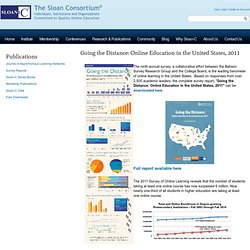
"While growth rates have declined somewhat from previous years, we see no evidence that a dramatic slowdown in online enrollments is on the horizon. " "There is a wide variety in rate of growth of online enrollments among different colleges and universities, and also among different programs within the same institution. For example, fully online health sciences programs show higher growth than online programs in other disciplines. " Key report findings include: Previously underwritten by the Alfred P. Building a UNESCO National Education Support Strategy (UNESS) Document: 2008-2013.pdf (объект «application/pdf») Can Thousands People Learn Anything from a massive Online Learning Class? By Audrey Watters, Mind/Shift Thousands of people have enrolled for Stanford’s online science and robotics classes.
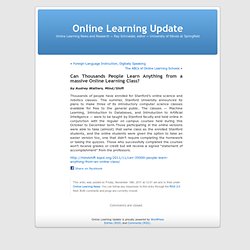
This summer, Stanford University announced its plans to make three of its introductory computer science classes available for free to the general public. The classes — Machine Learning, Introduction to Databases, and Introduction to Artificial Intelligence — were to be taught by Stanford faculty and held online in conjunction with the regular on campus courses held during this October to December term.Those participating in the online versions were able to take (almost) that same class as the enrolled Stanford students, and the online students were given the option to take an easier version too, one that didn’t require completing the homework or taking the quizzes. Those who successfully completed the courses won’t receive grades or credit but will receive a signed “statement of accomplishment” from the professors.
What Are The Real Elearning Standards? In the eLearning field, we usually come across SCORM/AICC as the standards to which the courseware should adhere to.
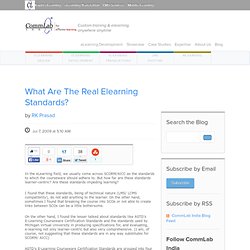
But how far are these standards learner-centric? Are these standards impeding learning? I found that these standards, being of technical nature (LMS/ LCMS compatibility), do not add anything to the learner. On the other hand, sometimes I found that breaking the course into SCOs or not able to create links between SCOs can be a little bothersome. A Free Learning Tool for Every Learning Problem? Seven Top Authoring Tools by Joe Ganci. “You choose the tools you need depending on the instructional design you need to implement, the venues to which you need to deliver, your budget and schedule, and other factors.
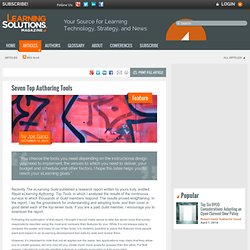
I hope this table helps you to reach your eLearning goals.” Recently The eLearning Guild published a research report written by yours truly, entitled Rapid eLearning Authoring: Top Tools, in which I analyzed the results of the continuous surveys to which thousands of Guild members respond. The results proved enlightening. In the report, I lay the groundwork for understanding and adopting tools, and then cover in good detail each of the top-seven tools. If you are a paid Guild member, I encourage you to download the report. Why Social Media Can and Is Changing Education. Cc licensed flickr photo shared by shareski Social media is something that has become so prevalent in our culture that I have seen everything from large companies to churches having their own facebook accounts.
When I first was presented with the idea that using Twitter, Facebook, or blogging as something in education I was weary of its application. As I have immersed myself in the process, and have seen my own staff and school use this themselves along with students, I have seen some tremendous changes in their practice. I really believe that using technology just to do the same things that we have always done, but on the computer, is not a good enough reason. There has to be more. The Best Web 2.0 Applications For Education In 2011. It’s that time of year again when I start posting year-end “The Best….” lists.
Coincidentally, this one is also the eight-hundredth “The Best…” list I’ve published! You can see them all here. I figured it was appropriate to make number 800 one that is likely to be the most popular post that I’ve published since I’ve begun this blog — the annual one highlighting The Best Web 2.0 Applications For Education. As usual, in order to make this list, a site had to be: * accessible to English Language Learners and non-tech savvy users. Coming Home As a Node in the Network. I’m organizing marketing material for a new business product my partner and I are developing.
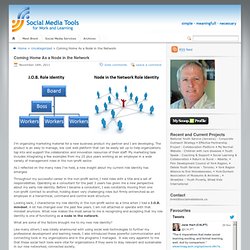
The product is an easy to manage, low cost web platform that can be easily set up to help organizations tap into and support the collaboration and innovation resources of their staff. My marketing task includes integrating a few examples from my 25 plus years working as an employee in a wide variety of management roles in the non-profit sector. As I reflected on the many roles I’ve held, a new insight about my current role identity has emerged. Throughout my successful career in the non-profit sector, I held roles with a title and a set of responsibilities. Operating as a consultant for the past 3 years has given me a new perspective about my early role identity. Looking back, I characterize my role identity in the non-profit sector as a time when I had a J.O.B. mindset. Analytics: Improving teaching and learning. The nature of technologies. You are not logged in. [] [] By Jon DronNovember 21, 2011 All technologies are assemblies that orchestrate phenomena to some purpose (Arthur, 2009).
They may consist of, use or embody tools that may be physical or conceptual or both. There are as much technologies of prayer as there are of steam locomotion (Franklin, 1999). Soft and hard technologies For some (e.g. I offer a consolidated definition: what makes a technology softer or harder is the degree to which the orchestration of phenomena is actively performed by a human or humans.
6 Tips: Maximize Learning with Interactivity in Courses - Tips 4 Blended Learning: Tools, Resources, and Apps. SchooX - The Academy for Self Learners - Online Courses and Certificates. The Ten Commandments of eLearning. 3 E-Learning Lessons Learned on the Road. I’m coming off of back-to-back-to-back conference sessions and elearning workshops.
While the travel gets old, I really enjoy getting to connect with so many of the blog readers. What I like best is that I run across so many different questions and elearning use cases and examples. I’m always amazed at the creativity in our industry. The principles of eLearning (cognitive theory of multimedia design) InShare26 I did a ten part series on the principles of eLearning as defined by researchers including Clark and Mayer and based largely on the cognitive theory of multimedia.
Often people ask me about how to access the eSeminar recordings so this blog entry is to provide a shortcut for folks looking to watch the seminars. 10: Making Effective Adobe Captivate eLearning Modules Part 10: Individual Differences Dr. Allen Partridge, Adobe eLearning Evangelist, will present a one hour online eSeminar for users of Adobe Captivate and / or Adobe eLearning Suite. Learning in the 21st Century Workplace.
Businesses talk about speed, but they don’t take advantage of it Organizations that don’t embrace new ways of operating and radically different approaches to corporate learning will not survive for three reasons: We’re witnessing a dizzying rate of change. Business people are being overwhelmed by the pace of progress and the explosion of knowledge.There are denser and denser interconnections afoot. Everything is getting hooked up to everything else. UkrEL2011-12-PLN4-Doklad2-Kravcov. UkrEL2011-08-PLN3-Doklad1-Juravskiy. UkrEL2011-07-PLN2-Doklad2-Zuban. UkrEL2011-06-PLN2-Doklad1-Krechman. UkrEL2011-05-PLN1-Doklad5-Trius. UkrEL2011-03-PLN1-Doklad3-Mazur.
VebinaryForUkrEL2011. Increased Investments in Learning Technologies - CHECK.point-elearning.com. Increased Investments in Learning Technologies London (UK), November 2011 - A UK learning-technology benchmark study shows how organisations are increasing their investment in learning technologies to help them respond faster to changing business conditions and build talent. The in-depth Towards Maturity Benchmark Study is in its eighth year and includes the data of 1,800 organisations in the private, public, and not-for-profit sectors.
A record 600 organisations participated in this year's study. The research findings revealed a staggering 77% of companies believe that learning technologies will help them respond faster to changing business conditions, an increase of 11% from 2010. Learning technologies are helping organisations reduce proven competency time by 35%, roll-out new IT systems faster by 33%, and improve product and processes changes by 33%. 58 Sites for Digital Storytelling Tools and Information. European Journal of Open, Distance and E-Learning. Dr. Lalita Rajasingham [lalita.rajasingham@vuw.ac.nz] Associate Professor, Communications Studies School of Information Management Victoria University of Wellington, New Zealand [ Abstract. A pedagogy of abundance or a pedagogy to support human beings? Participant support on massive open online courses.
Rita Kop and Hélène Fournier National Research Council of Canada John Sui Fai Mak Australia Abstract This paper examines how emergent technologies could influence the design of learning environments. ICCAI 95 article. LS2011: A Metrics-Performance-Learning Driven System. Ray Jimenez, PhD presented a case study for session 411 during the Learning Solutions conference. What he demonstrated was a very strong design which clearly integrates business objectives and job performance metrics with formal and informal development interventions.
Best articles on working smarter. 3 Ways E-Learning Will Look Different in 2013. Instructional Design Models. The following is a list of prescriptive instructional design models. Instructional Design Models & Theories. Unleashing the Potential of Technology in Education. ОБРАЗОВАНИЕ КАК ИНСТРУМЕНТСОЦИАЛЬНЫХ ТРАНСФОРМАЦИЙ:ПРОБЛЕМА ИНТЕРАКТИВНЫХ МЕТОДИК.pdf (объект «application/pdf») Pedagogical Design Tools: Planning for Learning with Purpose. Quality eLearning: An instructional design model for online learningin higher education.pdf (объект «application/pdf») 10 Helpful Tips for Using PowerPoint for E-Learning. A List of some of The Best Free Tools to Create Animated Pictures. Top 10 Social Web Products of 2011.
» November 2011 in review C4LPT Blog. Cоздание электронного контента. Learning in the 21st Century Means Adapting to Change. Why Are There No Successful Innovation Initiatives? Are These the Three E-Learning Books You Would Recommend? 20072004.pdf (объект «application/pdf») The top 50 new social media tools of 2011 - 'Nominations' Edition. SMART Technologies. #change11 as emerging out of complex networks and MOOC. The Future of Teaching Is Virtual: An Interview With Bena Kallick. Two Software Tools for Creating Simulations. National Standards - iNACOL. How Technology Can Improve Learner-Centered Teaching. Donald Clark Plan B. MOOC as Community of Practice. Top 100 apps - the definitive guide.
Use your PLN to help your PLC to become a CoP. 35 Ways to Use Google Apps in the Classroom NEW. Mobile Learning. Borut Pfeifer's Blog - Our digitally distributed futures... Missing the point – why a philosophy of learning is everything. Top Ten Free Educational Technology Applications I Learned (More) About at #ISTE11. 8 Big Ideas of the Constructionist Learning Lab. Three generations of distance education pedagogy. Interconnecting networks of practice for professional online learning. Google Plus for learning. Creative Commons. Метаданные для дистанционного обучения. Welcome to IMS Global Learning Consortium. Обсуждение материалов по дистанционному обучению.